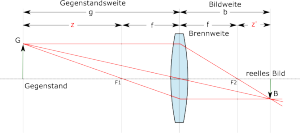Image formation of a lens. The values z und z’ are marked red.
The Newtonian equation is an equation of ray optics named after the English physicist Isaac Newton.
It reads
![]()
with
![]()
and
![]()
Solved for ObjectDistance we get:
![]()
Solved for ImageDistance we get:
![]()
This Newtonian Image equation is often used instead of the “lens equation”. Here z is the differences between object distance and focal length and z ‘ is the difference between image distance and focal length.
Be an object point 20mm left of the first Focal point of a lens of 30mm focal length.
Then it’s image is to the right of the second Focal point (“-” 20 because the left of the focal point).
to the right of the second Focal point (“-” 20 because the left of the focal point).
Then it’s image is
Be an object point 10mm left of the first Focal point of a lens of 30mm focal length.
Then it’s image is to the right of the second focal point (“-” 10 because the left of the focal point).
to the right of the second focal point (“-” 10 because the left of the focal point).
Then it’s image is
The advantage of Newton’s equation is that you can determine the focal point and distances from these focal points of lenses relatively easy, while principal points can be relatively difficult to determine.
